Assessing Sensitivity of Paddy Rice to Climate Change in South Korea
Abstract
:1. Introduction
2. Materials and Methods
2.1. Future Climate Change Scenarios
2.2. Paddy Water Requirement Calculations Using the Water Balance Model
2.3. Sensitivity Index of Vulnerability of Paddy Rice to Climate Change
2.4. Categorizing Climate Change Sensitivity of Paddy Rice
3. Results and Discussion
3.1. Temporal Changes in Paddy Water Requirements
3.2. Regional Changes in the Sensitivity Index of Paddy Rice
3.3. Categorization of Climate Change Sensitivity Types
4. Conclusions
- The future water balance of paddy fields was estimated using weather data over the past 40 years (1971–2010) as a baseline. Scenarios RCP 4.5 and 8.5 both showed an increase in consumptive use. The increase for RCP 8.5 (average 10.9%) was higher than for RCP 4.5 (average 7.5%). The annual precipitation during the cultivation period increased compared to the present in all periods, except for the 2010s and 2030s. However, effective rainfall varied according to climate change scenarios and periods due to effects of rainfall days, rainfall intensities, and freshwater conditions of the field. The net water requirement was predicted to increase overall in the future, but did not show a specific trend.
- Sensitivity of paddy rice to climate change was evaluated using the ratio of effective rainfall to consumptive use (REIP). Higher REIP values indicated favorable water balance conditions, and low sensitivity to climate change, and vice versa. Compared to the REIP values over the past 40 years, sensitivity improved only during the 2040s, 2060s, and 2080s for RCP 4.5, and during the 2040s and 2080s for RCP 8.5. In the regional analysis, both climate change scenarios showed high REIP values for L3 regions, but U1 regions generally showed the lowest REIP values overall, which predicted an increase in sensitivity to climate change.
- Cities and counties were categorized into four sensitivity types using the REIP: low consumption–water rich (LR), low consumption–water poor (LP), high consumption–water poor (HP), and high consumption–water rich (HR). In both RCP scenarios, the number of water-poor regions (LP and HP) increased overall compared to the present. The number of cities and counties that changed from LR to HP over an extended period was highest in the U1 region, which indicated that this region should be a priority for measures to adapt to climate change. However, the M3 region showed a high number of changes from HP to LR, and was predicted to experience the least adverse effects of climate change.
Acknowledgments
Author Contributions
Conflicts of Interest
References
- Parry, M.; Canziani, O.; Palutikof, J.; van der Linden, P.; Hanson, C. Climate Change 2007: Impacts, Adaption and Vulnerability; Cambridge University Press: Cambridge, UK, 2007. [Google Scholar]
- Korea Institute of Construction and Transportation Technology Evaluation and Planning (KICTTEP). Planning Research of Flood Defense Technology for Next Generation; Ministry of Land, Transport and Maritime Affairs: Anyang, Korea, 2008.
- Doll, P. Impact of climate change and variability on irrigation requirements: A global perspective. Clim. Chang. 2002, 54, 269–293. [Google Scholar] [CrossRef]
- Xiong, W.; Holman, I.; Lin, E.; Conway, D.; Jiang, J.; Xu, Y.; Li, Y. Climate change, water availability and future cereal production in China. Agric. Ecosyst. Environ. 2010, 135, 58–69. [Google Scholar] [CrossRef]
- Gondim, R.; Maia, M.; de Castro, M. Climate change and irrigation water need sensitivity analysis. Proc. Soc. Behav. Sci. 2010, 2, 7666–7667. [Google Scholar] [CrossRef]
- Li, Y.; Wu, W.; Ge, Q.; Zhou, Y.; Xu, C. Simulating Climate Change Impacts and Adaptive Measures for Rice Cultivation in Hunan Province, China. J. Appl. Meteorol. Climatol. 2016, 55, 1359–1376. [Google Scholar] [CrossRef]
- Chung, S.O. Climate change impacts on paddy irrigation requirement in the Nakdong river basin. J. Korean Soc. Agric. Eng. 2009, 51, 35–41. [Google Scholar] [CrossRef]
- Yun, D.-K.; Chung, S.-O.; Kim, S.-J. Climate change impacts on paddy water requirement. J. Korean Soc. Agric. Eng. 2011, 53, 39–47. [Google Scholar] [CrossRef]
- Lee, T.S.; Choi, J.Y.; Yoo, S.H.; Lee, S.H.; Oh, Y.G. Analyzing consumptive use of water and yields of paddy rice by climate change. J. Korean Soc. Agric. Eng. 2012, 54, 47–54. [Google Scholar] [CrossRef]
- Yoo, S.H.; Choi, J.Y.; Lee, S.H.; Oh, Y.G.; Park, N.Y. The impacts of climate change on paddy water demand and unit duty of water using high-resolution climate scenarios. J. Korean Soc. Agric. Eng. 2012, 54, 15–26. [Google Scholar] [CrossRef]
- McCarthy, J.J.; Canziani, O.F.; Leary, N.A.; Dokken, D.J.; White, K.S. Climate Change 2001: Impacts, Adaptation and Vulnerability; Cambridge University Press: Cambridge, UK, 2001. [Google Scholar]
- Fűssel, H.M.; Klein, R.J.T. Climate change vulnerability assessments: An evolution of conceptual thinking. Clim. Chang. 2006, 75, 301–329. [Google Scholar] [CrossRef]
- Fűssel, H.M. Review and Quantitative Analysis of Indices of Climate Change Exposure, Adaptive Capacity, Sensitivity, and Impacts; World Bank: Washington, DC, USA, 2010. [Google Scholar]
- Fellman, T. The assessment of climate change-related vulnerability in the agricultural sector: Reviewing conceptual frameworks. In Building Resilience for Adaptation to Climate Change in the Agriculture Sector, Proceedings of a Joint FAO/OECD Workshop, Rome, Italy, 23–24 April 2012; FAO: Rome, Italy, 2012; pp. 37–61. [Google Scholar]
- Korea Meteorological Administration (KMA). Korean Climate Change Assessment Report 2014; Korea Meteorological Administration: Seoul, Korea, 2014.
- Allen, R.G.; Pereira, L.S.; Raes, D.; Smith, M. Crop Evapotranspiration—Guidelines for Computing Crop Water Requirements—FAO Irrigation and Drainage Paper 56; Food and Agriculture Organization of the United Nations: Rome, Italy, 1998. [Google Scholar]
- Yoo, S.H.; Choi, J.Y.; Jang, M.W. Estimation of design water requirement using FAO Penman—Monteith and optimal probability distribution function in South Korea. Agric. Water Manag. 2008, 95, 845–853. [Google Scholar] [CrossRef]
- Lee, N.H. Simulating Daily Operation of Water Management System of Irrigation Districts. Ph.D. Thesis, Seoul National University, Seoul, Korea, 1988. [Google Scholar]
- Jang, M.W.; Chung, H.W.; Choi, J.Y.; Park, K.W.; Bae, S.J. Development a single reservoir agricultural drought evaluation model for paddy. J. Korean Soc. Agric. Eng. 2004, 46, 17–30. [Google Scholar]
- Choi, J.Y.; Yoo, S.H.; Oh, Y.G.; Lee, S.H.; Yun, D.K. Evaluation of the future agricultural water demand under the climate change scenarios. In Water for Future; Korea Water Resources Association: Seoul, Korea, 2012; Volume 45, pp. 73–83. [Google Scholar]
- Chen, J.; Brissette, F.P.; Leconte, R. Uncertainty of downscaling method in quantifying the impact of climate change on hydrology. J. Hydrol. 2011, 401, 190–202. [Google Scholar] [CrossRef]
- Deser, C.; Phillips, A.; Bourdette, V.; Teng, H. Uncertainty in climate change projections: The role of internal variability. Clim. Dyn. 2012, 38, 527–546. [Google Scholar] [CrossRef]
- Oh, S.G.; Suh, M.S.; Lee, Y.S.; Ahn, J.B.; Cha, D.H.; Lee, D.K.; Hong, S.Y.; Min, S.K.; Park, S.C.; Kang, H.S. Projections of high resolution climate change for South Korea using multiple-regional climate models based on four RCP scenarios. Part 2: precipitation. Asia-Pac. J. Atmos. Sci. 2016, 52, 171–189. [Google Scholar] [CrossRef]
- Li, Z.; Liu, W.; Zhang, X.; Zheng, F. Impacts of land use change and climate variability on hydrology in an agricultural catchment on the Loess Plateau of China. J. Hydrol. 2009, 377, 35–42. [Google Scholar] [CrossRef]
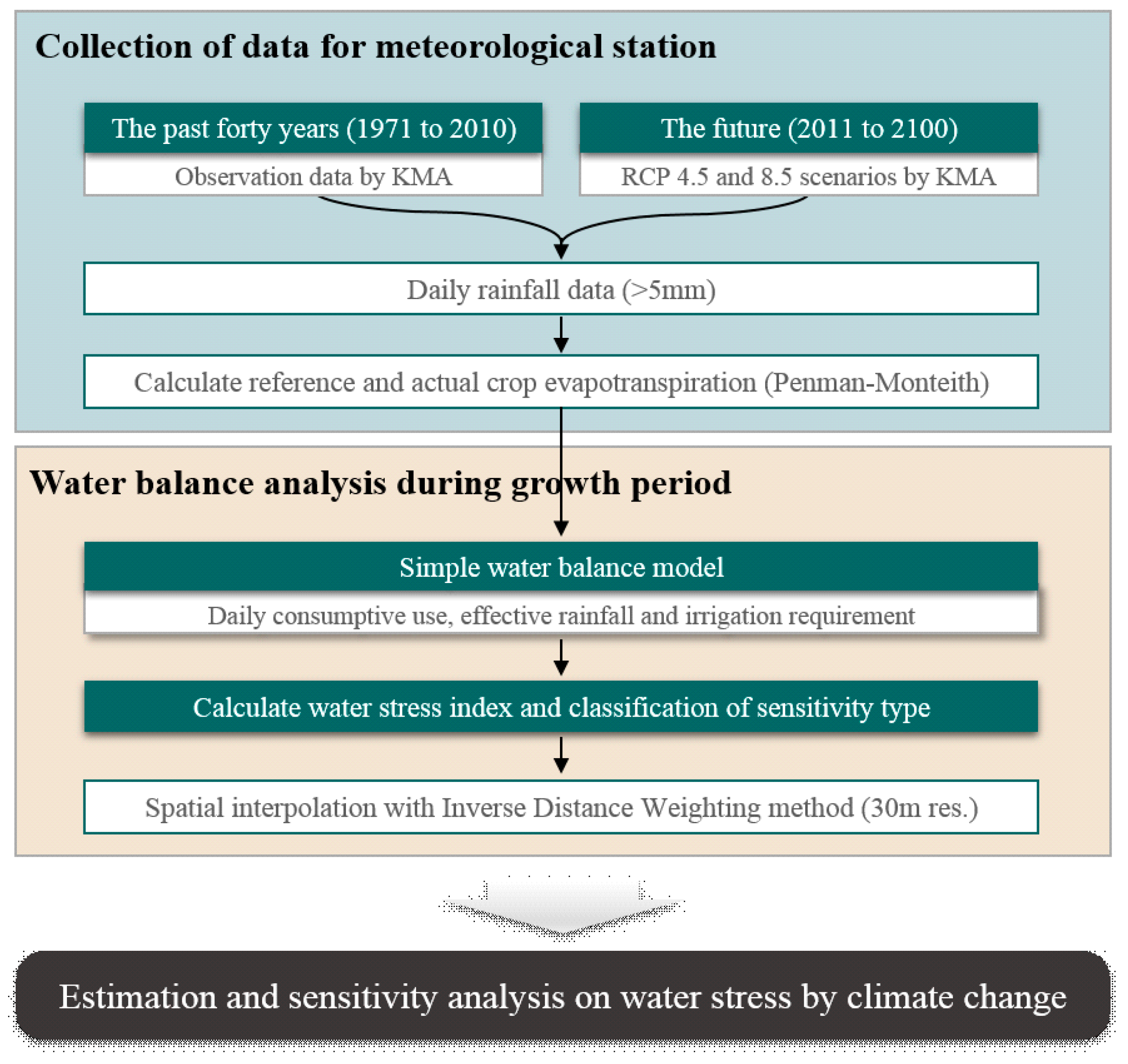
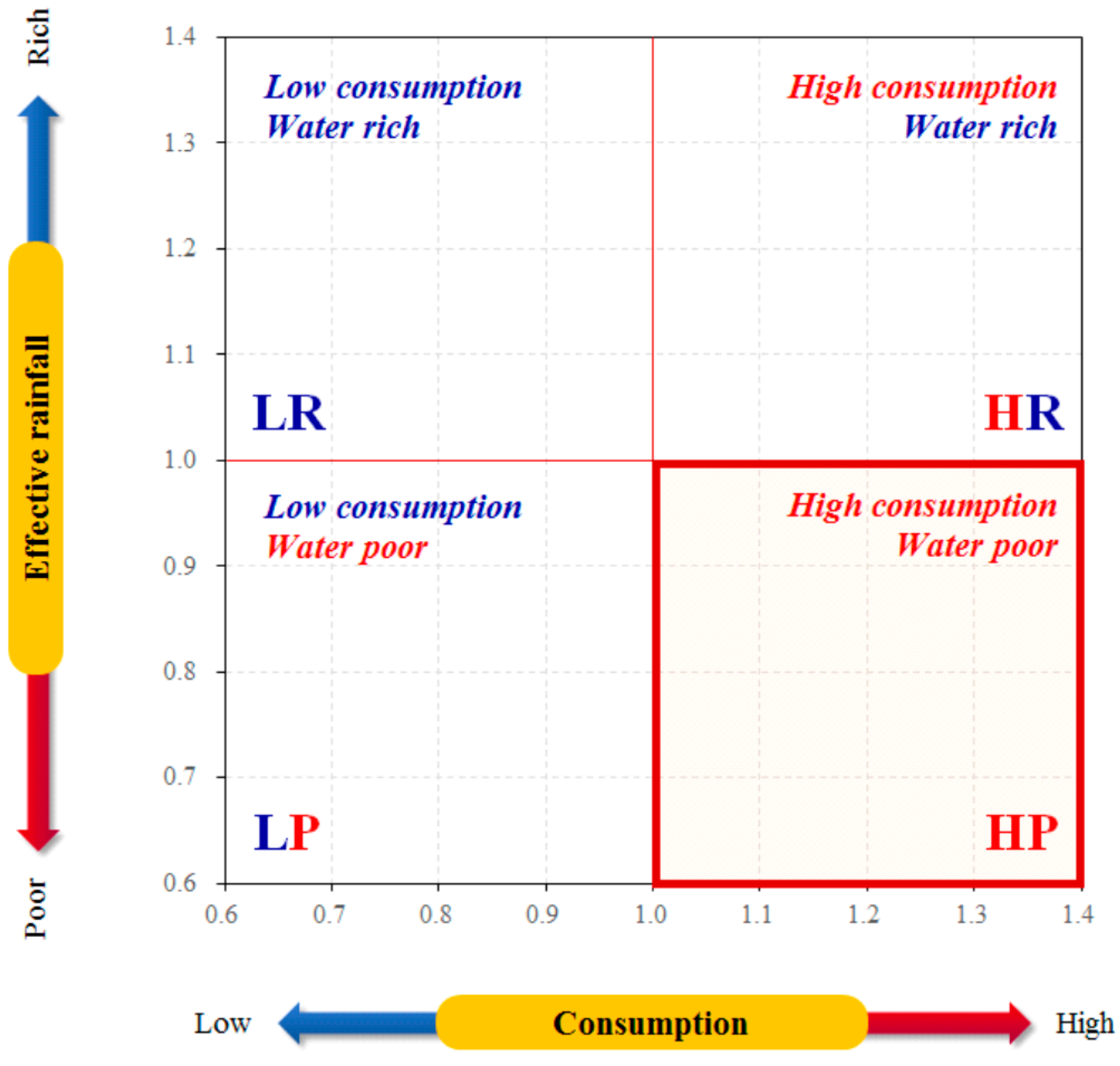
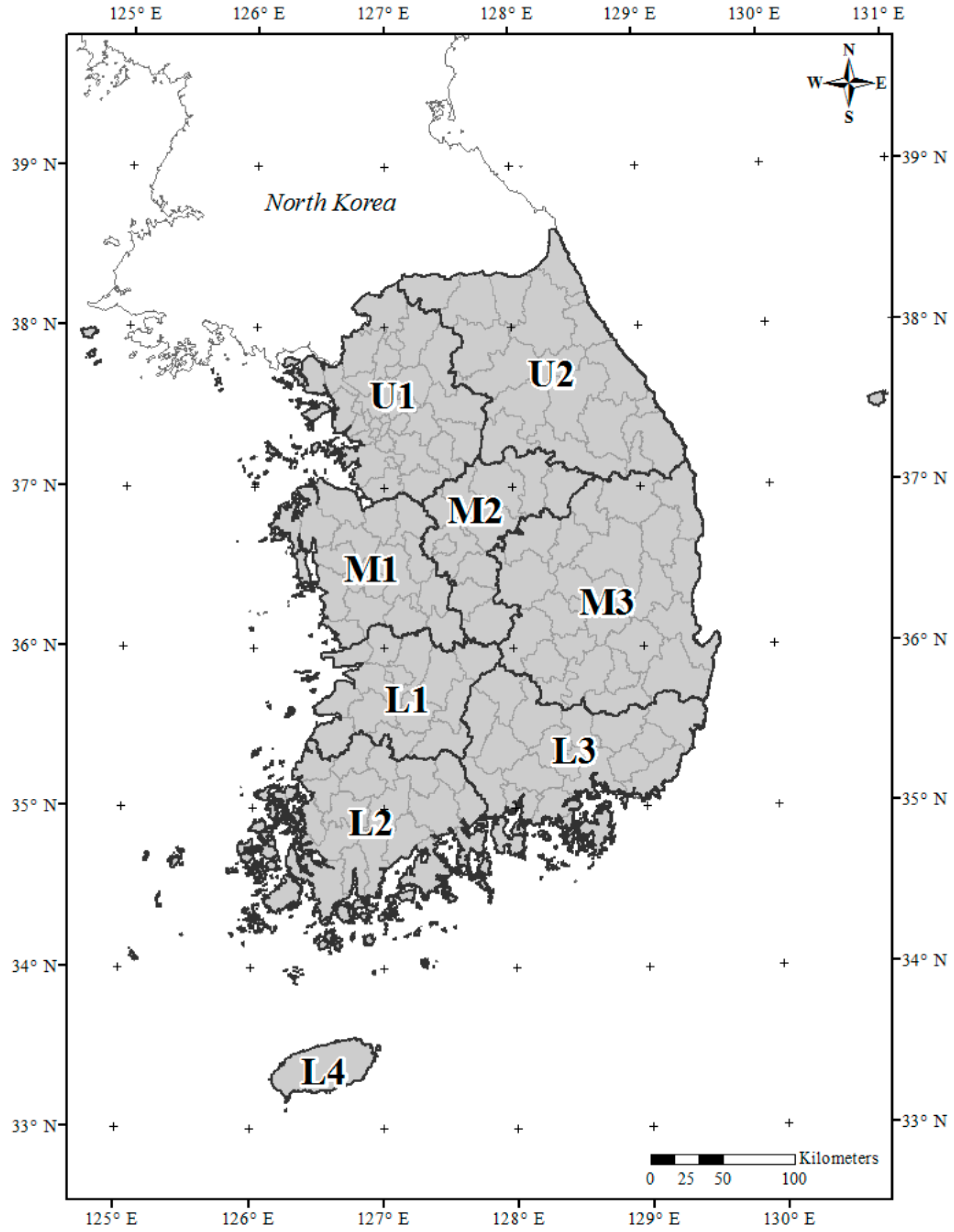

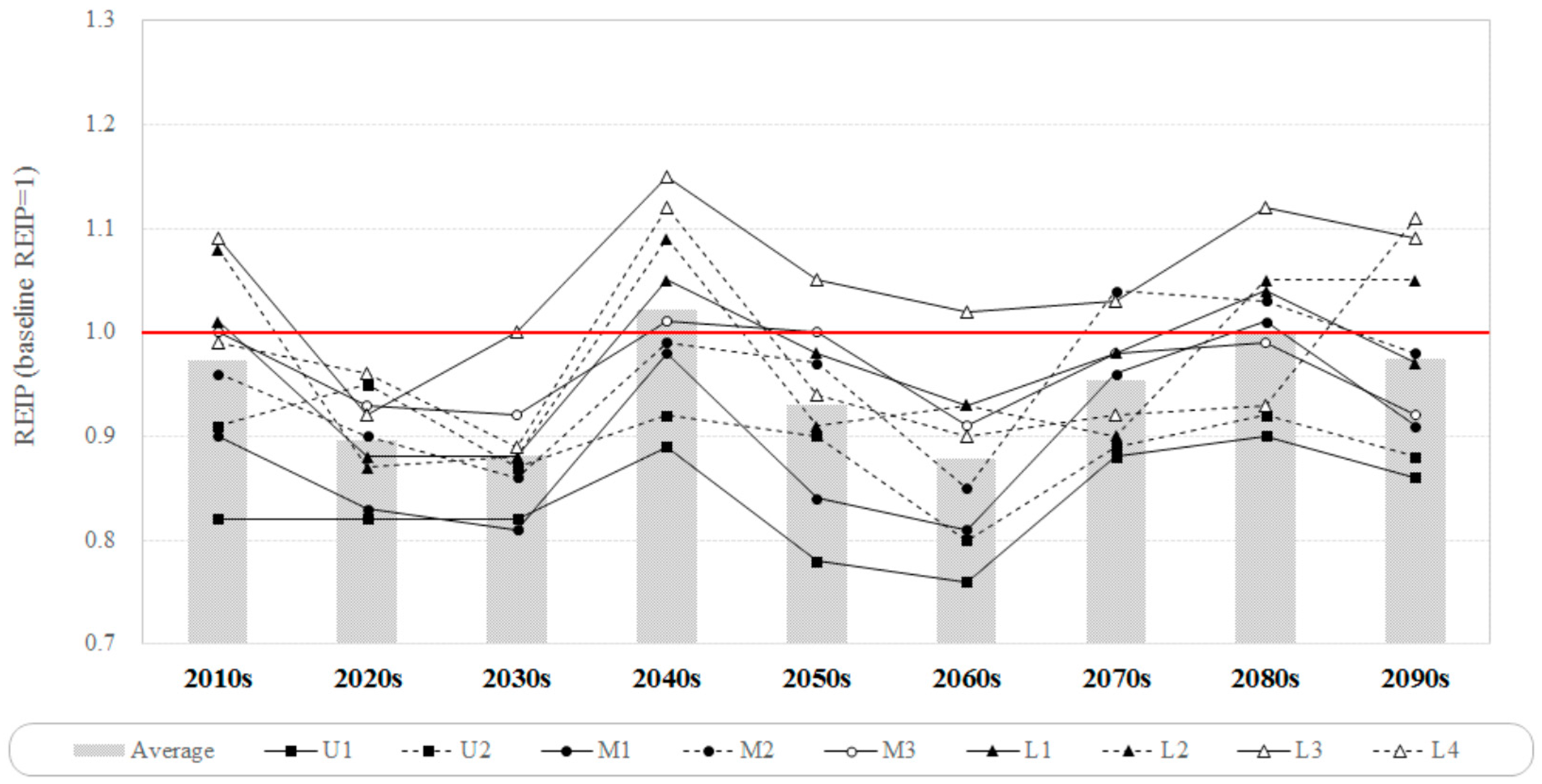

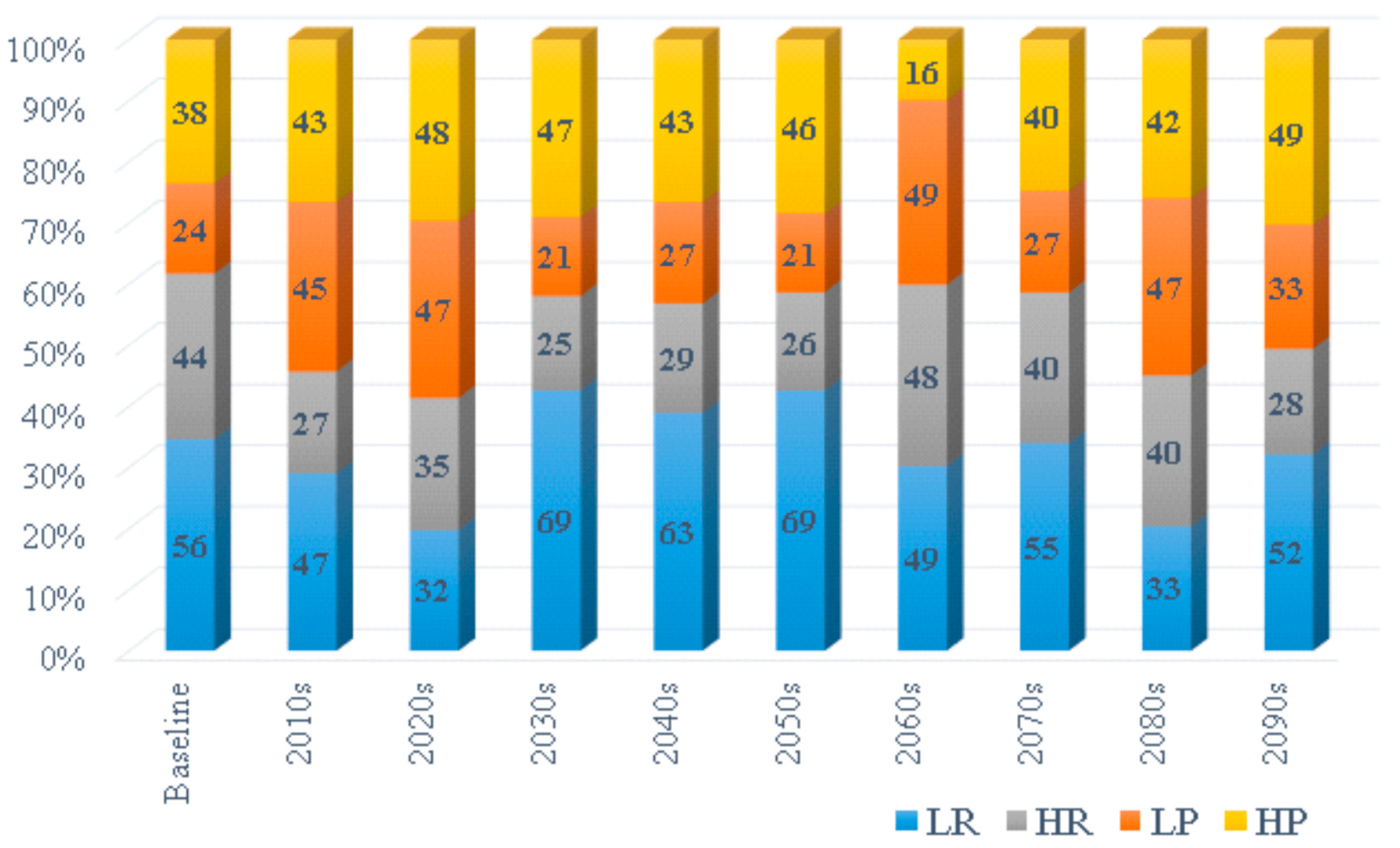
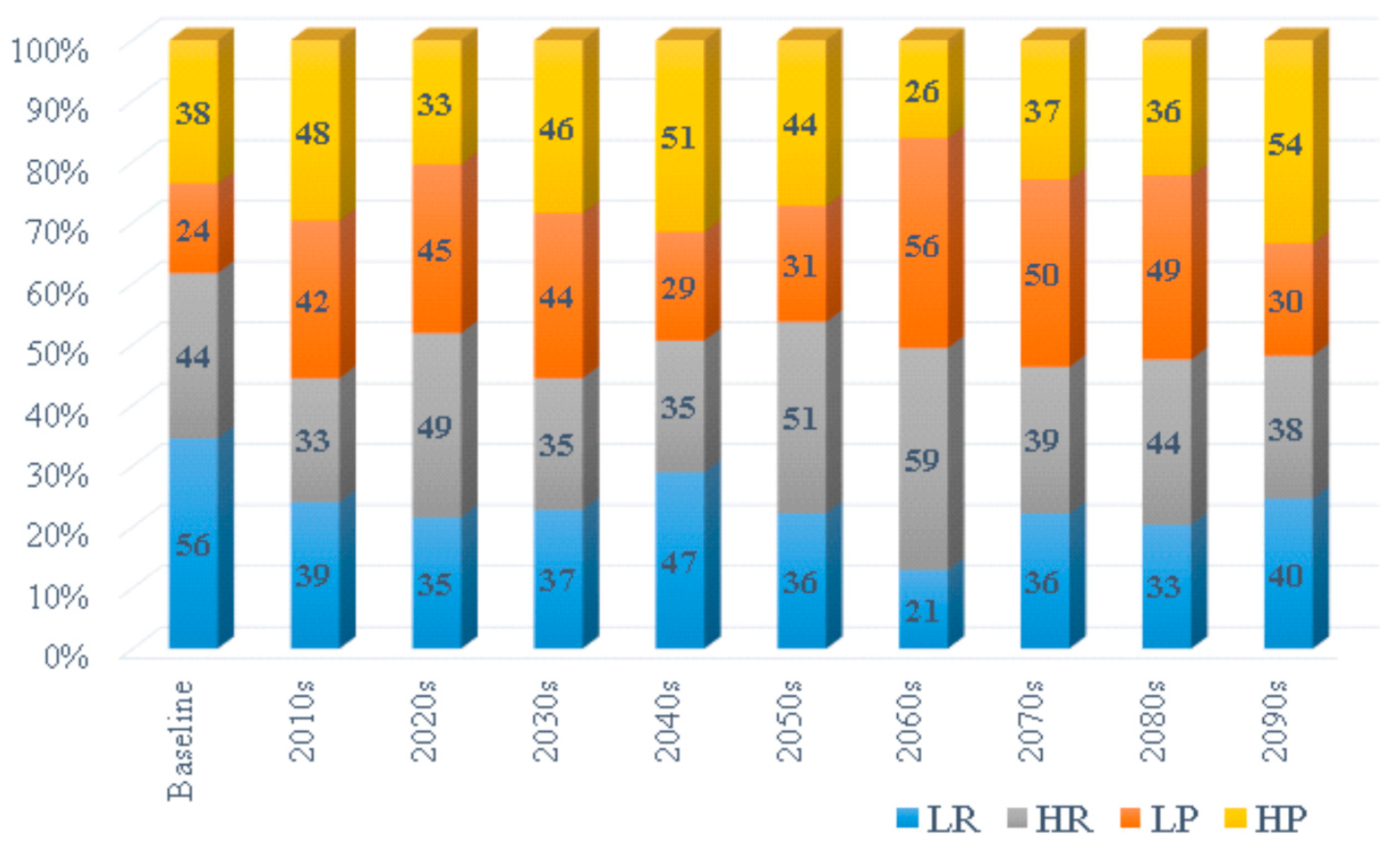
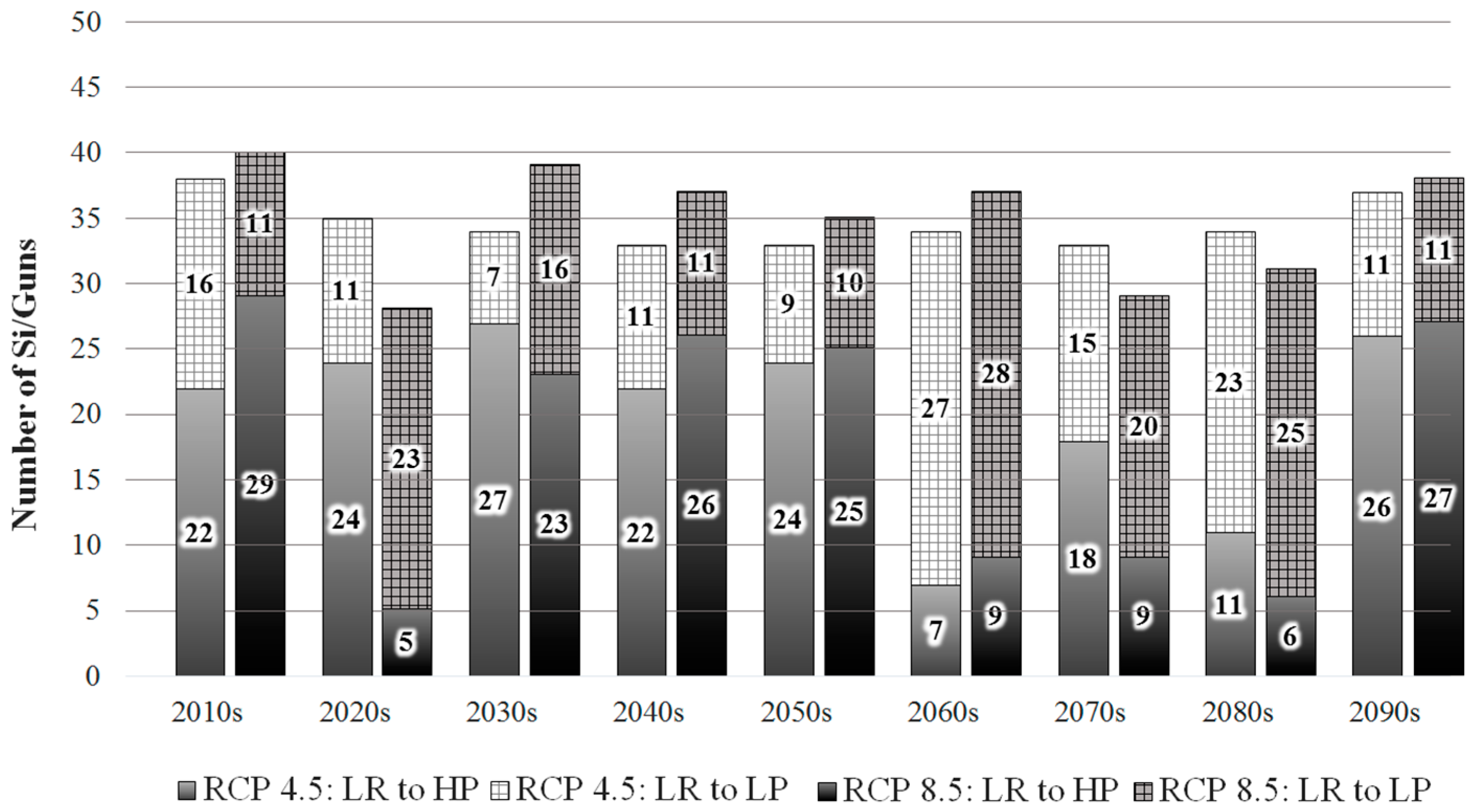

| Period | No. of Meteorological Stations | Climate Data | Source |
|---|---|---|---|
| 1970s (1971–1980) | 62 | Observed | KMA |
| 1980s (1981–1990) | 68 | Observed | KMA |
| 1990s (1991–2000) | 72 | Observed | KMA |
| 2000s (2001–2010) | 81 | Observed | KMA |
| 2010s (2011–2020) to 2090s (2091–2100) | 60 | Climatic change scenarios (RCP 4.5 and 8.5) | KMA |
| Days after Transplanting | 10 | 20 | 30 | 40 | 50 | 60 | 70 | 80 | 90 | 100 | 110 | 120 |
|---|---|---|---|---|---|---|---|---|---|---|---|---|
| Crop coefficients | 0.78 | 0.97 | 1.07 | 1.16 | 1.28 | 1.45 | 1.50 | 1.58 | 1.46 | 1.45 | 1.25 | 1.01 |
| Days Since Seeding | 30 | 40 | 70 | 90 | 110 | 130 | |||||
|---|---|---|---|---|---|---|---|---|---|---|---|
| Growth stage | Pre-planting | Trans-planting | Tillering | Elongation | Heading | Ripening | |||||
| Ponding depth | 20 | 60 | 40 | 0 | 20 | 30 | 30 | 30 | 40 | 40 | 0 |
| Period | PR (mm) | CU (mm) | ER (mm) | IR (mm) | ||||
|---|---|---|---|---|---|---|---|---|
| RCP 4.5 | RCP 8.5 | RCP 4.5 | RCP 8.5 | RCP 4.5 | RCP 8.5 | RCP 4.5 | RCP 8.5 | |
| 1970s | 748 | 547 | 472 | 583 | ||||
| 1980s | 876 | 539 | 498 | 559 | ||||
| 1990s | 890 | 536 | 488 | 562 | ||||
| 2000s | 954 | 522 | 515 | 521 | ||||
| 2010s | 851 | 918 | 576 | 549 | 473 | 492 | 605 | 571 |
| (−1.8%) | (5.9%) | (7.4%) | (2.4%) | (−4.1%) | (−0.3%) | (8.7%) | (2.6%) | |
| 2020s | 939 | 893 | 555 | 575 | 485 | 467 | 584 | 623 |
| (8.3%) | (3.0%) | (3.5%) | (7.2%) | (−1.6%) | (−5.2%) | (4.9%) | (11.9%) | |
| 2030s | 865 | 848 | 594 | 579 | 492 | 470 | 602 | 626 |
| (−0.2%) | (−2.2%) | (10.7%) | (7.9%) | (−0.2%) | (−4.6%) | (8.3%) | (12.6%) | |
| 2040s | 1066 | 1057 | 550 | 581 | 541 | 549 | 534 | 548 |
| (22.9%) | (21.9%) | (2.6%) | (8.4%) | (9.7%) | (11.4%) | (−4.0%) | (−1.6%) | |
| 2050s | 990 | 996 | 573 | 600 | 518 | 508 | 569 | 602 |
| (14.2%) | (14.9%) | (6.9%) | (11.9%) | (5.1%) | (3.0%) | (2.3%) | (8.3%) | |
| 2060s | 1235 | 869 | 564 | 627 | 578 | 499 | 496 | 616 |
| (42.5%) | (0.2%) | (5.1%) | (16.9%) | (17.2%) | (1.2%) | (−10.9%) | (10.8%) | |
| 2070s | 1018 | 1093 | 600 | 605 | 506 | 532 | 609 | 594 |
| (17.4%) | (26.1%) | (11.8%) | (12.9%) | (2.7%) | (7.9%) | (9.4%) | (6.8%) | |
| 2080s | 1062 | 1150 | 566 | 597 | 533 | 551 | 538 | 571 |
| (22.5%) | (32.7%) | (5.5%) | (11.4%) | (8.2%) | (11.7%) | (−3.2%) | (2.6%) | |
| 2090s | 886 | 1127 | 611 | 641 | 489 | 570 | 620 | 590 |
| (2.2%) | (30.0%) | (13.9%) | (19.5%) | (−0.8%) | (15.7%) | (11.5%) | (6.2%) | |
| Period | RCP 4.5 | RCP 8.5 | Region | RCP 4.5 | RCP 8.5 | ||||
|---|---|---|---|---|---|---|---|---|---|
| Avg | Std | Avg | Std | Region | Avg | Std | Avg | Std | |
| 2010s | 0.91 | 0.078 | 0.97 | 0.087 | U1 | 0.85 | 0.093 | 0.84 | 0.049 |
| 2020s | 0.96 | 0.117 | 0.90 | 0.050 | U2 | 0.91 | 0.091 | 0.89 | 0.042 |
| 2030s | 0.90 | 0.092 | 0.88 | 0.056 | M1 | 0.91 | 0.080 | 0.89 | 0.076 |
| 2040s | 1.06 | 0.073 | 1.02 | 0.088 | M2 | 0.98 | 0.089 | 0.95 | 0.069 |
| 2050s | 0.98 | 0.061 | 0.93 | 0.083 | M3 | 0.99 | 0.089 | 0.96 | 0.041 |
| 2060s | 1.11 | 0.090 | 0.88 | 0.081 | L1 | 1.04 | 0.089 | 0.97 | 0.062 |
| 2070s | 0.93 | 0.072 | 0.95 | 0.059 | L2 | 1.02 | 0.094 | 0.97 | 0.092 |
| 2080s | 1.03 | 0.063 | 1.00 | 0.071 | L3 | 1.09 | 0.081 | 1.05 | 0.070 |
| 2090s | 0.88 | 0.083 | 0.97 | 0.091 | L4 | 0.97 | 0.094 | 0.97 | 0.086 |
| Avg | 0.97 | 0.081 | 0.95 | 0.074 | Avg | 0.97 | 0.089 | 0.95 | 0.065 |
© 2016 by the authors; licensee MDPI, Basel, Switzerland. This article is an open access article distributed under the terms and conditions of the Creative Commons Attribution (CC-BY) license (http://creativecommons.org/licenses/by/4.0/).
Share and Cite
Kim, S.; Bae, S.; Kim, S.; Yoo, S.-H.; Jang, M.-W. Assessing Sensitivity of Paddy Rice to Climate Change in South Korea. Water 2016, 8, 554. https://doi.org/10.3390/w8120554
Kim S, Bae S, Kim S, Yoo S-H, Jang M-W. Assessing Sensitivity of Paddy Rice to Climate Change in South Korea. Water. 2016; 8(12):554. https://doi.org/10.3390/w8120554
Chicago/Turabian StyleKim, Soojin, Seungjong Bae, Sorae Kim, Seung-Hwan Yoo, and Min-Won Jang. 2016. "Assessing Sensitivity of Paddy Rice to Climate Change in South Korea" Water 8, no. 12: 554. https://doi.org/10.3390/w8120554






